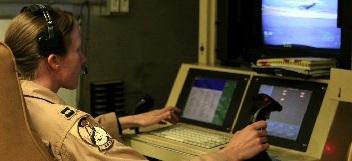Feb 28 2013
The U.S. Department of Defense reports that drone accidents in which personnel or aircraft are damaged or destroyed occur 50 times more often than mishaps involving human-operated aircraft. The U.S. Marines and Army reported 43 mishaps that involved human factors issues associated with drone ground control workstations and technology during 2006−2007.

Human factors/ergonomics (HF/E) researchers Qaisar Waraich, Thomas Mazzuchi, Shahram Sarkani, and David F. Rico suggest that multimillion-dollar drone losses might be prevented if long-established and broadly applied HF/E workstation design standards had been used in designing workstations used by ground controllers.
In their Ergonomics in Design article, "Minimizing Human Factors Mishaps in Unmanned Aircraft Systems," the authors propose applying long-established commercial computer workstation standards, particularly ANSI/HFES 100-2007 Human Factors Engineering of Computer Workstations, in the absence of more specific guidelines for drone ground control workstations or a federal agency that is responsible for setting workstation standards.
Waraich et al. interviewed 20 drone operators about their ground control workstations, finding up to 98% similarity between input/output devices used in ground control workstations and those used for general purposes. Therefore, results, the authors posit that standards that have been used to improve general-purpose workstations could have the same result for drone operators' workstations. The researchers included UAS designers with the U.S. Navy, systems engineering researchers from George Washington University, and engineers from top airframe manufacturers.
Application of design guidelines from ANSI/HFES 2007-100 might have prevented the awkward placement of a landing gear button and the subsequent loss of a $1.5-million drone in 2006. Similarly, had design guidelines been applied for reducing glare from a computer screen, a drone operator might not have mistakenly shut off engines midair, resulting in the loss of a $4.34 million drone.
"The application of this standard could help to ensure that operator workstation equipment and layouts have been designed with human compatibility considerations," says Waraich. "Commercial computer workstation standards provide quantitative parameters based on empirical data and well-established HF/E engineering practices."
Drones have been, and will continue to be, used in a broad range of applications, including police surveillance and natural disaster research, and ground control workstation designers can benefit from incorporating HF/E principles and standards.